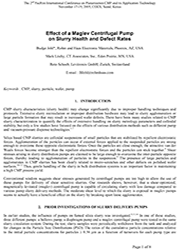

CMP slurry characteristics (slurry health) may change significantly due to improper handling techniques and protocols. Extensive slurry recirculation or improper distribution hardware may lead to slurry agglomeration or large particle formation that may result in increased wafer defects. There have been many studies related to CMP slurry characterization to quantify the effects of extensive handling on slurry metrology parameters and colloidal stability, but only a few studies have focused on the effects of various distribution methods such as different pump and vacuum-pressure dispense technologies.
Silica based CMP slurries are colloidal suspensions of small particles that are stabilized by repellent electrostatic forces. Agglomeration of the particles can occur if external forces applied to the suspended particles are strong enough to overcome these opposite electrostatic forces. Once the particles are close enough, the attractive van der Waals forces become stronger than the repellent electrostatic forces and the particles can stick together. Shear stresses arising in slurry distribution pumps are claimed to be large enough to overcome the inter-particle opposite forces, thereby leading to agglomeration of particles in the suspension. The presence of large particles and agglomerates in CMP slurries has been clearly related to micro-scratches and other defects on polished wafer surfaces. Thus, gentle handling of the slurry in bulk distribution systems is an important factor in maintaining a high CMP process yield.
Conventional wisdom suggests shear stresses generated by centrifugal pumps are too high to allow the use of these pumps for delivery of shear sensitive slurries. Our research shows, however, that a shear-optimized, magnetically levitated (maglev) centrifugal pump is capable of circulating slurry with less damage compared to various pump slurry delivery methods. The moderate shear level to which the slurry is exposed in maglev pumps seems to actually have a beneficial effect on the slurry by breaking apart loose agglomerates.
We found no results for “keyword”
Please check for typos. The product you are searching for may not be a standard Levitronix product or is not yet on our site.
Can`t find what you are looking for?
Contact usYour account has been created and a verification email
has been sent to your registered email address.
Please check on the verification link included in the email to activate your account.
Return to Sign InAlready have an account?
Please enter your information below.
Not a member? Create account
